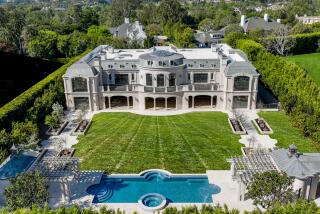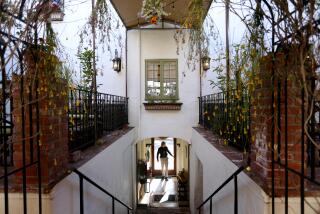Landmark Decision
CAMARILLO — For Bert Lamb and his wife, Linda, the Victorian house they’ve lived in for 21 years is the only home their four children have ever known.
But to the city of Camarillo, it is the house that gave birth to a city--and therein lies the rub.
The house on Mission Oaks Boulevard was built in 1892 by city founder Adolfo Camarillo and, as such, is one of the area’s most prized historic homes.
So when Lamb and his relatives wanted to sell some of the farmland around their ancestral home for industrial use, the city saw its opportunity:
In exchange for the rezoning needed to make the sale profitable, Lamb had to give up living in the house and arrange a complicated deal to ensure the new owner deeded it over to the city.
Lamb, who had hoped to stay in the house his great-grandfather built, will move his family out next month. The deal, he said, not only forced him out but left the Camarillo heirs with less money than they might have made on a land sale.
“I think my grandfather would be rolling over in his grave if he knew what the city of Camarillo did to the Camarillo family,” said Lamb, who also farms on some of the family’s remaining land in the Santa Rosa Valley. “They have gone out of their way to make things difficult.”
But city officials say the deal was key to preserving a historic landmark and opening it up to the community. The city plans to rent the 106-year-old, Queen Anne style home for weddings and special occasions, as well as using it for community functions.
“The city was not going to let them sell off the property without letting them resolve the issue of the house,” City Manager Bill Little said. “As far as I’m concerned, that was the right way to do it because that house is very important to the city.”
No one debates that the venerable house is worth preserving.
It was home to Camarillo’s most celebrated pioneer, Adolfo Camarillo, who farmed 10,000 acres of land and laid the foundation for the city that bears his name.
Under Adolfo’s direction, the family ranch prospered along with the rest of Ventura County. Aside from the acres of walnut groves he was best known for, his lucrative business rapidly expanded to include livestock, dairy and a winery.
The house was the hub of the community’s social life. Back then, rodeos, barbecues and other events were put on by the family for the entire community.
But the future of the house stood on shaky ground after Adolfo’s death in 1958. Inheritance taxes ate up most of the estate, and a good portion of land had to be sacrificed to pay off the debt.
Carmen Jones, one of Adolfo’s daughters, inherited the white, eight-bedroom home and lived there for a time until the upkeep became too costly.
With no one to help defray the costs, in 1969 Jones deeded the house to Province St. Augustine Church to be used as a seminary. The deed included 15 acres immediately surrounding the house.
Adolfo’s heirs kept another 52 acres around that.
When the seminary closed its doors a little more than two decades ago, the home was left without a caretaker. The church, however, authorized Jones to use the property as she chose until it was sold.
The timing couldn’t have been better for Bert and Linda Lamb. It was 1977 and they had just married. Jones, his great-aunt, offered the home to the couple just starting out, as a favor to her.
“She really liked the fact that the house was back in the family,” Lamb said. She died a decade ago, and the Lambs stayed on in the house.
But farming the surrounding 52 acres became more difficult, with the growth of the sprawling bedroom community and a burgeoning industrial area near the farm.
In addition, when the city assessed landowners for a new freeway offramp at Flynn Street, it cost the heirs half a million dollars.
So about two years ago, Lamb, his cousin Gerald FitzGerald and two other heirs decided to sell the agricultural land for industrial use, recognizing the property had appreciated.
But selling the land did not prove as simple as putting up a “for sale” sign.
It seemed that time had enhanced the city’s interest in obtaining the house for historical preservation.
“In the early ‘60s, this was not a historical landmark, it was just a white elephant that needed a lot of work and needed somebody to take care of it,” Lamb said. “[The city] was not interested in it then.”
But when the family decided to sell its 52 acres, city officials said they needed to ensure the house’s future and safeguard against developers’ clearing the land.
“We made it very clear that if the property got sold, that the city wanted the house and the surrounding grounds in order to preserve it,” City Manager Little said.
Lamb’s first reaction was to try to buy the house that he had grown so attached to over the years.
“I was told by the powers that be to stay away from that, that the city wanted that land,” he said.
Little acknowledged that selling the house became a condition of rezoning the land to industrial use, key to making the property more attractive to potential buyers.
But because the church had owned the house and the 15 acres around it for the past 40 years, it was not the family’s to sell.
To satisfy the city’s demands, the family had to persuade the church to sell its house and property jointly with the family’s property to a single buyer.
More problematic was the caveat that the new owners would be required to quitclaim the deed to the city. The city made no attempt to buy the house, family members say.
“To find a developer to cooperate with that deal was hard to get,” said FitzGerald.
Under city planning ordinances, the city can require property owners to hand over property for use as parks, easements or other city purposes as long as it serves a public interest.
But family members characterize this case as a misuse of that power.
“This deal is so shady, it stinks,” Lamb said. As part of the deal, the city was also able to acquire eight acres of land, a house and several other buildings that weren’t deemed historic.
Family members finally grew weary of the chess game with city officials, including City Manager Little and Planning Director Tony Bodin.
“Mr. Bodin said, ‘Thou shalt not sell without the house,’ ” FitzGerald said. “At that point we knew, you can’t fight city hall.”
The family joined in an agreement with the Augustine church to sell both plots of land. The property sold in April to Centex Industrial Development, based in Dallas. The deal paid the heirs of Camarillo’s estate $3.7 million--slightly more than the assessed value in 1987, the last time it was assessed.
“We were forced to sell the land at almost sacrificial prices to allow developers to come into the area,” FitzGerald said. “The [house] turned out to be a white elephant for us.”
The church was paid $1.2 million for its 15 acres, a higher price per acre.
The real estate development company would say only that the complexity of the property made the large family-owned parcel of land less valuable.
“From [the family’s] standpoint, if the house hadn’t have been there they would have realized more money,” said Scott Johnson, vice president of Centex Development Corp. “If we could have paid more for the 67 acres, then we could have used more and they would have gotten more.”
Construction has begun on the parcel near the house. Diamondback Bicycles recently broke ground for a new plant, which will serve as its national headquarters.
The developers say they plan to place other industrial plants on that parcel and have struck a deal with city planners to make the construction as unobtrusive as possible, to maintain the house’s integrity.
Less than one week before the house’s Sept. 22 anniversary, the Lamb family will move out, making them the last of Adolfo Camarillo’s descendants to live in the home.
“It’s going to be hard to move,” Lamb said. “I love the old place. It’s neat.”
More to Read
Sign up for Essential California
The most important California stories and recommendations in your inbox every morning.
You may occasionally receive promotional content from the Los Angeles Times.










